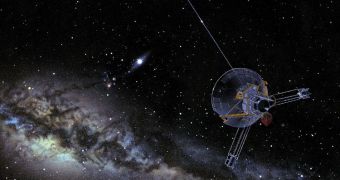Some time ago, mission controllers at NASA detected a minuscule tendency of the two Pioneer spacecraft to slow down, as they were traveling towards the edge of the solar system. Finally, after laborious investigations, experts figured out what was causing the so-called Pioneer Anomaly.
Investigators at the NASA Jet Propulsion Laboratory (JPL), in Pasadena, California say that the subtle effect is caused by heat emanating from the vehicles' own electronic instruments. The thermoelectric power supply is also responsible for a portion of this effect.
According to JPL expert Slava Turyshev, the lead author of the new study, the subtle phenomenon could be compared to the photons emitted from the headlights of a car pushing back at the automobile. The amount of push would be extremely small, but present nonetheless.
This effect was recorded on the NASA Pioneer 10 and 11 spacecraft, experts say. Details of the new investigation and the explanations it provides appear in the June 12 issue of the esteemed scientific journal Physical Review Letters.
The two vehicles took off in 1972 and 1973, respectively, and were set on a trajectory meant to take them out of the solar system. As they were traveling by Saturn, in the early 1980s, scientists noticed a small drop in speed, akin to a small, but constant deceleration.
Though at first dismissed as a technical issue, the problems entered scientists' attention yet again, this time in 1998. Careful studies of the available data revealed a deceleration of 300 inches per day squared (0.9 nanometers per second squared).The work was led by JPL expert John Anderson.
Since 2004, Turyshev has been collecting a wealth of data on the Pioneer spacecraft displaying the speed anomaly, including data communication patterns, telemetry data and Doppler readings. The expert and his team collected a total of 43 gigabytes of data, which is quite a lot for the 1970s.
Compared to other spacecraft, the team determined, the Pioneer probes were not stabilized on all three axis via thrusters, but rely on spin to keep their course. This may also contribute to the small effect.
“The story is finding its conclusion because it turns out that standard physics prevail. While of course it would’ve been exciting to discover a new kind of physics, we did solve a mystery,” Turyshev says, adding that the first studies of the anomaly led physicists to believe a new type of physics was involved.

 14 DAY TRIAL //
14 DAY TRIAL //